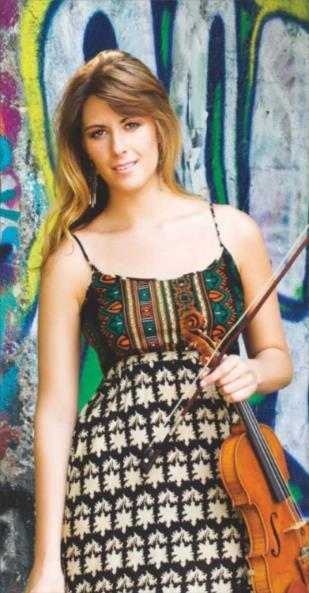The Italian violinist on practising under pressure and how Paganini is her constant companion. From October 2016

Discover more Featured Stories like this in The Strad Playing Hub.
This article was published in The Strad October 2016 issue
I always practise best under pressure. Often I have to give many back-to-back concerts with different repertoire, and when I realise I’m behind on the completely unrealistic schedule I’ve made for myself, I suddenly become very responsible and studious. The most important thing is never to let practice become rushed.
Right now my last-minute study includes the Sibelius Concerto for a tour in the Netherlands, and Mozart’s K218 and K219 concertos for performances in Italy. Practising such contrasting repertoire can be tricky. I’m careful never to practise Mozart after playing hours of Sibelius, because I would never be able to control my bow weight, pacing and vibrato.
Today I give myself a tough workout on the Sibelius: I start the metronome app on my iPhone and study fast passages mechanically over and over, under tempo, then gradually accelerate. I let part of my mind wander during this sort of practice, but never lose focus on intonation, clean shifting, articulation and bow speed.
On rehearsal days I try not to practise the featured piece too much. I usually revise the tough spots slowly and then move on to something else. On concert days I practise for an hour in the morning (usually the cadenza and encores, which I won’t have worked on enough previously) and try to sleep for most of the day. One useful thing is to repeat passages I wasn’t happy with on stage as soon as I get back to the dressing room. If I shrug off a passage I had trouble with, it festers so I risk having the same problem at the next concert. It only takes a few minutes but it’s a lifesaver.
A very exciting item on my practice menu at the moment is the Brahms Violin Concerto, for concerts in Cologne next March. Concentrating on performances so far ahead is not typical for me, but in this case it’s extremely interesting because I’m working with Roger Norrington, changing and analysing different aspects of my approach to this masterpiece. Working with him towards a more pure and agile Brahms for these performances is fascinating. In situations like this, when I’m returning to repertoire that I’ve performed a lot in the past, I find myself changing all the bowings and fingerings, then usually going back to the original ones! This is part of a deeper process that involves phrasing, tone production and looking for new solutions. Sometimes it’s useful to play through the whole piece in tempo, almost like a dress rehearsal, just to feel what work still needs to be done.
As always, there is some Paganini on my music stand. The sheer muscular and mental effort his works require give me something to strive for, and I get great satisfaction out of achieving it. My love–hate relationship with Paganini makes me push myself to confront and overcome my limits. Recording and performing all 24 Caprices was one of the toughest but most rewarding feats of my life.
Right now I’m concentrating on his First Violin Concerto. I’ll be recording it shortly alongside Wolf-Ferrari’s lush and virtually unknown concerto, and although I’ve played it dozens of times, everything needs to be totally secure because Paganini just tends to ‘feel’ different in public, or under pressure. You have to be 250 per cent prepared if you want your performance to be 100 per cent. As it’s so difficult for the muscles to handle, I give myself a practice goal: today, I play the whole concerto through slowly three times in a row, to build up the stamina I will need in the studio.
This concerto is very lyrical and incredibly Italian, so when I have finished my practice I listen to as much opera as possible. Rossini is the best, because it gives me the perfect feeling of what Paganini was listening to and what inspired him. The soaring themes need to be theatrical but extremely pure, and the virtuosic passages are ironic, humorous and full of character, just like in bel canto opera. Additionally, reading as much as possible about the composer makes it easier for me to focus completely on what I am doing. It’s a good way to fill long waiting times when I travel – until the day some music-loving airport official decides to introduce practice rooms in terminals!
Read: Sentimental Work: Francesca Dego on Brahms’s Violin Concerto
Listen: The Strad Podcast Episode #4: Francesca Dego on playing ‘Il Cannone’
Read more Featured Stories like this in The Strad Playing Hub.
The number one source for playing and teaching books, guides, CDs, calendars and back issues of the magazine.
In The Best of Technique you’ll discover the top playing tips of the world’s leading string players and teachers. It’s packed full of exercises for students, plus examples from the standard repertoire to show you how to integrate the technique into your playing.
The Strad’s Masterclass series brings together the finest string players with some of the greatest string works ever written. Always one of our most popular sections, Masterclass has been an invaluable aid to aspiring soloists, chamber musicians and string teachers since the 1990s.
American collector David L. Fulton amassed one of the 20th century’s finest collections of stringed instruments. This year’s calendar pays tribute to some of these priceless treasures, including Yehudi Menuhin’s celebrated ‘Lord Wilton’ Guarneri, the Carlo Bergonzi once played by Fritz Kreisler, and four instruments by Antonio Stradivari.





































No comments yet